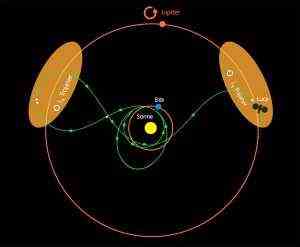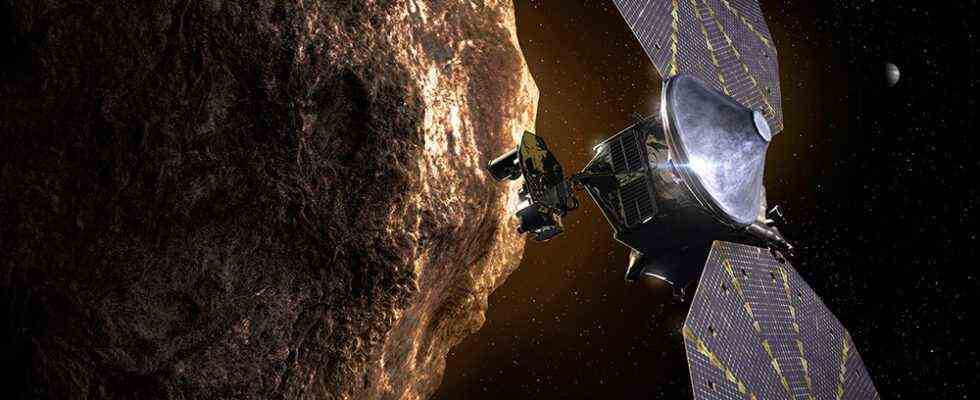On Saturday the NASA space probe “Lucy” started on a mission with an unusual goal. Because the probe is to visit the Jupiter Trojans for the first time – asteroids that orbit Jupiter’s orbit. Unlike the chunks in the asteroid belt, these Trojans come from the outer regions of the solar system. Investigating them could therefore provide fascinating information about the early development of this distant region and the routes by which asteroids and comets enter the inner system.
After the formation of planets in the solar system was complete, a large part of the remaining chunks gathered together with early collision debris in the Asteroid belt between Mars and Jupiter. It mainly contains stony, arid asteroids that formed in the inner part of the earlier primeval cloud. In contrast, celestial bodies from the ice-rich zones of the primeval nebula gathered further out. These comets, dwarf planets and asteroids are mainly found in the Kuiper belt beyond Neptune.
Trojans – Ancient chunks in the orbit of Jupiter
But there are also asteroids that orbit between the planets of the outer solar system or even directly on their orbit – the latter are referred to as Trojans. Tens of thousands of these chunks, up to 250 kilometers in size, gather in two places in front of and behind the planet near Jupiter. At these so-called Lagrange points, the forces of attraction of the Sun and Jupiter are balanced. This allows objects to revolve around these points in stable orbits.
On Jupiter, two large clouds of such asteroids are concentrated around its Lagrange points 4 and 5, which are 60 degrees in front of and behind the planet and follow it on its orbit around the sun. Planetary researchers suspect that many of these chunks were already during the hike of the young Jupiter were captured in today’s orbit by the outer edge of the primeval cloud. They could therefore still be largely unchanged relics from this region.
“That makes these ‘time capsules’ very interesting for a more detailed investigation,” explains Stefano Mottola from the Institute for Planetary Research at the German Aerospace Center (DLR). “We hope to gain significant new knowledge about the earliest times of the solar system and the formation of the planets.” At the same time, the data could provide more information about it which routes and through which processes celestial bodies get inside from the outer solar system.
First visit by a space probe
The NASA space probe Lucy is now to visit these Jupiter Trojans for the first time and examine them more closely. Because of their great distance from Earth, their small size and their low brightness, they are hardly visible to telescopes. The space probe, which was launched from the Cape Canaveral spaceport on October 16, 2021, could therefore for the first time discover the essential properties of these primordial relics.
To do this, she has three scientific instruments on board with which she can spectroscopically examine the chemical and physical characteristics of the asteroids. Camera recordings should also show the surface and structure of some selected Trojans in greater detail. “The exact shape of the asteroids is derived from the data from the navigation cameras,” explains Mottola. In addition, subtle shifts in the frequencies of the radio waves that “Lucy” sends back to earth should provide information about the internal composition and mass of the Trojans.

Lengthy, tortuous approach
However, it will be a few years before that happens. Because in order to reach the two Trojan clouds at the Lagrange points of Jupiter, the NASA space probe has to fly a few loops. First of all, it will gain momentum for its journey to Jupiter’s orbit in two flyby flights and reach the asteroid belt in 2025. There it passes the main belt asteroid 52246) Donaldjohanson before continuing.
In 2027, the space probe will first reach the swarm of Jupiter Trojans, which hurry ahead of the planet at Lagrange point L4. The target objects there are the asteroid Eurybates with its moon Queta, as well as the asteroids Polymele, Leucus and Orus. After Lucy has worked through this “visit list” by November 2028, she will be directed back into the inner solar system to Earth – a novelty in the history of space travel.
The reason for this: only through this large loop and a renewed flyby of the earth can the space probe change its orbit so that it can also head for the rear cloud of the Jupiter Trojans next. “Lucy” will reach these objects circling around the Lagrange point L5 in March 2033. There the double asteroid (617) Patroclus is on her examination program.
The nominal mission of the space probe is then over, but if there is enough fuel and the resources necessary for the mission operation, the mission could be extended and “Lucy” and other Trojans explore Jupiter’s orbit.
Source: NASA, German Aerospace Center (DLR)

